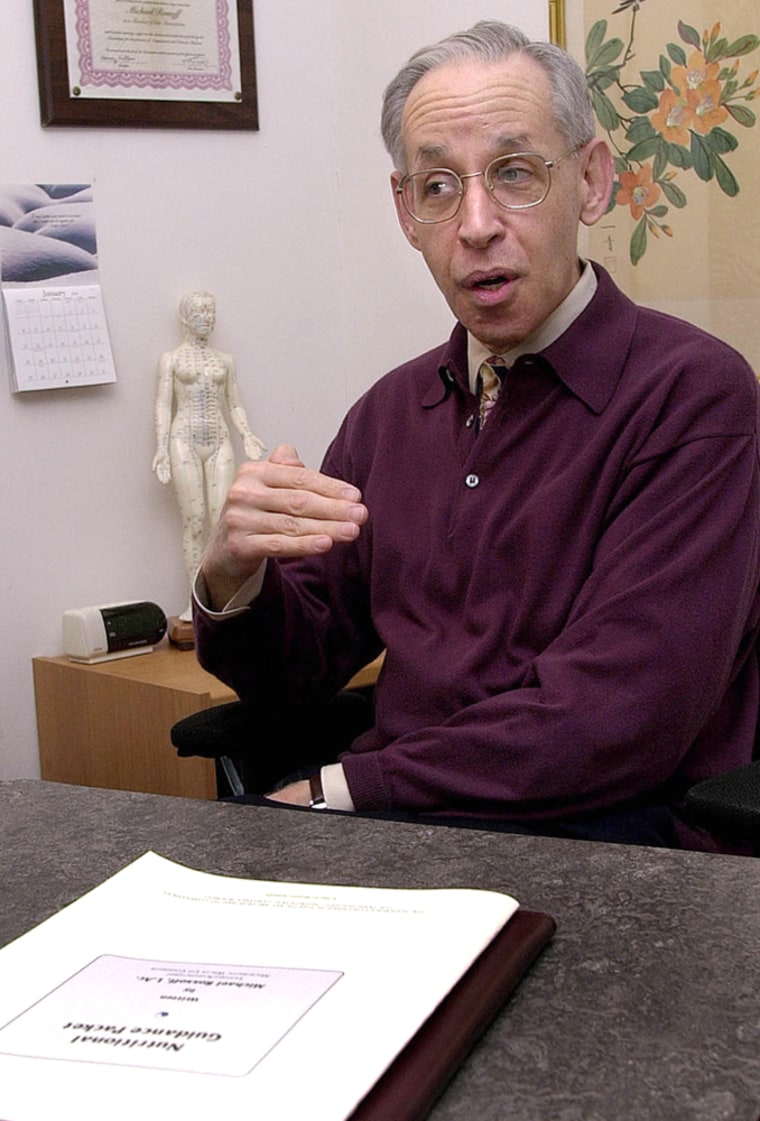In an age of low-carb diets and high-protein energy bars, Michael Rossoff is an anomaly. In his world, vegetables reign over excessive meat. He does not “got milk” — and counsels his clients to do the same.
For more than three decades, the respected whole foods counselor has practiced macrobiotics — a diet embraced by health-conscious eaters ranging from Gwyneth Paltrow and Madonna to yogis and cancer patients.
“I haven’t eaten red meat in 30 years,” Rossoff declared during a recent interview. “I suppose the (Atkins) people haven’t made much money off of me.”
At 58, Rossoff is energetic, clear-eyed, smooth-skinned and “probably 25 pounds lighter” than his twin brother, who hasn’t adopted the diet.
Macrobiotics was brought to the United States from Japan five decades ago by Michio and Aveline Kushi, founders of the thriving Kushi Institute near Boston. Rossoff studied for years with the Kushis and, as a senior macrobiotic counselor, draws a steady following at teach-ins and workshops.
Holistic lifestyle
The word “macrobiotics” is derived from “long life” in Greek. It is a holistic lifestyle concept anchored by a diet heavy on vegetables, grains, beans, soups and the bounty of the sea — including fish and sea vegetables. It eschews refined sugar, red meat, dairy, white flour, antibiotic-laced poultry and eggs.
Those who eat macrobiotically tend to follow the seasons — fresher, lighter fare in the summer versus more root vegetables, pressure-cooked grains, and oils in the winter.
As Rossoff puts it, “You don’t wear shorts in the snow or a fur coat in Miami.”
Practitioners strive for balance when creating meals. That balance extends beyond fat and calories and considers the “energetic properties” of food.
“Think of the Chinese concept of yin and yang,” the idea of opposite energies in harmony, Rossoff says. Root vegetables come from deep in the ground and have a “grounding” effect on the body. Conversely, corn stalks grow high toward the sun, energetically imparting its lightness and vigor.
Yin and yang
In macrobiotics, yin foods (such as leafy vegetables and fruits) have a cooling, expansive effect on the body. Refined sugar is extremely yin. At the opposite end of the spectrum, eggs and beef are extremely yang, those denser foods which have a heating, tightening effect on the body’s internal workings.
“In that tradition,” Rossoff explains, “brown rice would be considered the most balanced food, the one with equal parts yin and yang. So if brown rice lies in the middle, ideally you want to stay within that area to stay balanced.”
That means eating foods that have been minimally processed and don’t come in a box, says Jane Quincannon Stanchich, who along with her husband and fellow teacher Lino Stanchich relocated to Asheville from Miami, adding to the city’s roster of macrobiotic teachers.
A mountain setting and tolerant attitudes cocoon Asheville, the largest city in western North Carolina, which attracts a wide spectrum of people leading holistic lifestyles. Other macrobiotic hubs include New York, San Francisco, and Austin, Texas.
'The anti-cancer diet'
Macrobiotics has become so popular among cancer patients that it is also known as “the anti-cancer diet.” And it’s being studied by institutions such as the Duke Comprehensive Cancer Center, the University of California San Diego Cancer Center, and the University of Texas M.D. Anderson Cancer Center.
Stanchich touts the diet’s variety.
“There are so many vegetables, all sorts of whole grains like millet and kamut, fish, tofu, tempeh (a tofu product),” she says, adding that macrobiotic meals often exceed the government’s recommended daily allowances of vitamins and minerals.
“And if you want something sweet, there are desserts sweetened with rice syrup, barley malt, or Rice Dream ’ice cream.’ I never feel deprived.”
Macrobiotics preaches that refined sugar may leach calcium from the bones, compromise the immune system and cause mood swings, especially in those prone toward depression. Eating sugar may cause cravings for foods from the other extreme of the yin/yang chart, and vice-versa.
“That’s why we want a really sweet dessert after a steak dinner,” Stanchich says. “Our body is craving balance, but a burger, fries, and a shake isn’t what creates it.”
Better energy and health?
Macrobiotics also emphasizes chewing food well.
“My husband wrote a book on this because he noticed that people in this country think chomping down a few times is chewing,” she said. “It just creates digestive disorders... Stomachs can’t chew.”
All that chewing, rice, and calm eating may be what leads people to associate macrobiotics with a monkish lifestyle, Rossoff jokes.
Dr. Jane Teas of the University of South Carolina’s School of Public Health is studying macrobiotics under a research grant from the Centers for Disease Control and Prevention. Her research shows people who eat macrobiotically report better energy and health, but with a caveat.
“The biggest cost is social isolation,” she says, adding it isn’t for everyone.
Teas tried the diet herself and thought the food tasted great.
But her husband and 12-year-old daughter thought otherwise. Experiencing tension while eating is very un-macrobiotic. Teas had to give up the diet to keep peace at the dinner table.
